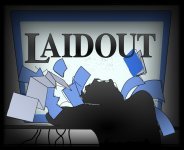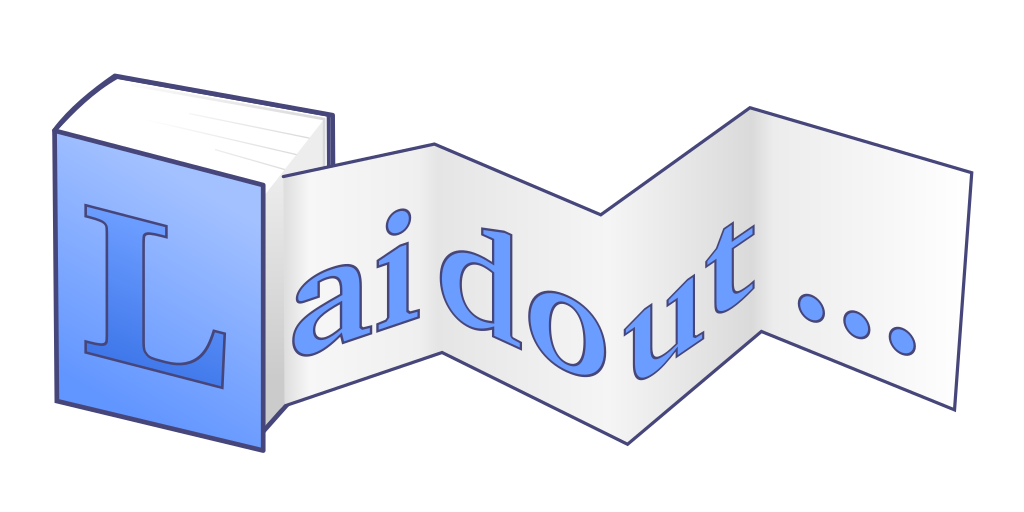DTP and experimental vector graphics tools
Version 0.097
News
Behold the new Laidout website! Which looks a lot like the old website!
But now it’s made with Hugo and hosted on Gitlab.
A few months ago, I went to the fabulous Libre Graphics Meeting,
and left feeling inspired a bit to make some long overdue updates to Laidout.
While development has been rather slow due to my time being taken up by working
on Godot based projects, hiking a lot,
and generally trying to pay bills,
there are a couple of new things to report.
One of two new tools lets you directly make ellipses, with optional wedges cut out, and another tool
lets you make rounded rectangles, allowing you to adjust the roundedness by dragging handles on screen.
These two tools are also implementations in support of large, on canvas, grabable UI areas to change properties,
rather than trying to grab tiny little dots to adjust things.
My current primary goal before a release is expanding imposition options
so you can stack signatures from the same sheet of paper. The old behavior
let you tile multiple signatures across a paper, but it could only duplicate,
rather than stack.
In other imposition news, I’ve implemented various basic net templates for
common single sheet flyers, that do various accordion type folds, like a gate fold, half fold, and others,
including an obscure one called a Miura fold.
This one is a map folding type where the pages are slightly
skewed quadrilaterals, which makes folding and unfolding easier. Invented by astrophysicist Kōryō Miura,
this type of fold has been used in solar cell folding for satellites! Alas, they did not use Laidout
for this purpose.
In addition to working on nets, I also expanded the Singles imposition type to handle so called
art board arrangements, where you can see multiple, different sized pages
at the same time. You might recognize this layout style in Inkscape’s new multipage feature.
Laidout can import and export this Inkscape svg with the revamped Singles imposition type.
At least it could before Inkscape reimplemented it to use svg view boxes instead
of custom namespace attributes! Working on it.
New “Stable” release 0.098 “soon”?
Sure? Maybe? I don’t know! I’m getting there! I swear!

This post was not actually written in 2006, however it does commemorate when the
very first version of Laidout was released, Version 0.01 on 12 March 2006!
How on earth have I gotten so old?! I had actually been sketching out and slowly coding this since 2004, but
it took a couple years to finally have a basically “stable” version.
My todo list has never gotten smaller!
What the hell?
Laidout is desktop publishing software built for impositioning.
Currently one may arrange pages into various cut and folded impositions, such as a booklet,
or even a dodecahedron.
For example, one can make small booklets by chopping up
tabloid sized paper (11x17 inches). With a fold, two cuts, and stapling, one can make three cute
little 5.5 x 5.6 inch books.
See the Laidout Features page for more detail about what it can do now,
the Roadmap for what it's supposed to do eventually, and this
(incomplete) comparison to a few other desktop publishing and vector graphics programs.
It is in the "Mostly does what I want on my machine" stage of development.
I try to have a new "stable" release once
in awhile, at least when various other projects
don't eat all my time, which seems to happen a lot lately.
"Stable" in this context means that it is only slightly less buggy then the raw development branch.
I have been using Laidout to lay out my comics into books since 2006.
So, one out of 8 billion people agree that Laidout might actually be useful!
Many more features are planned, like such non-essentials (to me anyway) as flowed text boxes. Who needs text
when a picture is worth a thousand words?
System Requirements
Laidout only works on variations of Linux for now.
It might work on Macs after a small amount of hacking, or maybe under Windows with WSL.
Please shower me with money if you need it to work on those platforms, or let me know
if you find a way to make it work there.
Download
The "Stable" version is rather old. I'm
working on it. If you can,
please use a development snapshot (also really old) or compile from source.
The main
0.097 download area is here.
You can help turn Laidout into something stable (without quotes) by posting issues to the
issue tracker,
or by
dropping me a line.
Compiling from "stable" source
If you download the source code form, you must compile and install from the command line. First, as root or with "sudo", install dependencies:
apt-get install g++ pkg-config libpng-dev libgegl-dev libreadline-dev libx11-dev libxext-dev libxi-dev libxft-dev libcups2-dev libimlib2-dev libfontconfig-dev libfreetype6-dev libssl-dev xutils-dev libcairo2-dev libharfbuzz-dev libsqlite3-dev libgraphicsmagick++1-dev zlib1g-dev mesa-common-dev libglu1-mesa-dev libftgl-dev
And then:
tar xvfj laidout-0.097.tar.bz2
cd laidout-0.097
./configure --prefix=/usr/local
make
make install
Some of the dependencies above (from mesa-common-dev on) are for the unstable polyhedron unwrapper.
You don't need them if you disable the opengl based unwrapper by passing
--nogl to the configure line above. The unwrapper exists also in
a standalone version in
laidout-0.097/src/polyptych.
If there is a problem with missing icons, you can use prebuilt icons from
laidout-icons.zip.
Instead of compiling as above, you can build a deb package from the source tar like the following. You'll need to have dpkg-dev and fakeroot packages installed.
This will create an installable deb package. If you try this and it doesn't work, please let me know. It is supposed to work!!
tar xvfj laidout-0.097.tar.bz2
cd laidout-0.096
dpkg-buildpackage -rfakeroot
Development
If you think you might like to help develop Laidout, please see
this page.
Development source code is currently hosted at
the git repository here,
or you can grab a copy from the repository with this command:
git clone https://github.com/Laidout/laidout.git
To actually compile from this git source, see the further instructions in the
Compiling From Development Git section
of the
README.
Contact
For most things, you can post an issue at Laidout's
issue tracker.
Currently, the only developer is Tom Lechner,
and he has been hacking away at Laidout to help make his
artwork
and otherwise experiment with interface design.




